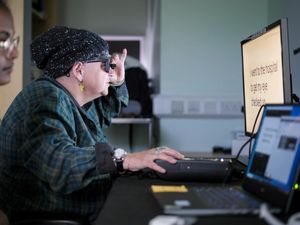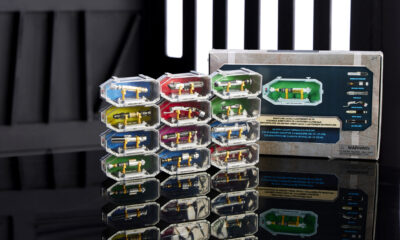Science
Blind Patients Regain Vision with Innovative Eye Implant

A groundbreaking electronic eye implant has enabled individuals with vision loss from a common age-related condition to read again. The innovative device, known as the Prima, measures only 2mm by 2mm and is half the thickness of a human hair. It is implanted beneath the retina, which is the layer of light-sensitive tissue in the eye, allowing patients previously deemed blind to see letters, numbers, and words. This advancement marks a significant leap in artificial vision technology, according to experts.
The first clinical trial of the Prima device involved 38 patients across 17 sites in five countries, including the UK, France, Italy, and the Netherlands. All participants suffered from geographic atrophy (GA), a severe form of dry age-related macular degeneration (AMD). GA impacts approximately five million people globally and can lead to complete sight loss as the central macula deteriorates. Estimates suggest that about one in four individuals who are legally blind in the UK have GA resulting from AMD.
Patients in the trial had lost central vision in the affected eye and retained only limited peripheral sight. The surgical procedures took place at Moorfields Eye Hospital in London approximately three years ago, each lasting under two hours. Surgeons performed a vitrectomy to remove the gel-like substance from inside the eye, creating a small trapdoor under the retina where the tiny chip was inserted.
To facilitate reading and writing, participants wore augmented-reality glasses equipped with a video camera. This camera connects to a small computer worn at the waist, which features a zoom capability to enlarge text. The camera captures images, projecting them as an infrared beam onto the chip, which activates the device. Artificial intelligence in the computer processes the information, converting it into electrical signals that travel through the retina and optical nerve to the brain, where they are perceived as visual images.
Dr. Mahi Muqit, a senior vitreoretinal consultant at Moorfields Eye Hospital and the UCL Institute of Ophthalmology, described the impact of the device as “life-changing” for patients. He stated, “I have all these patients who are blind, and when you see them, they want to know if there is anything that can restore vision. The answer has always been no. Now, we’ve got some patients who are reading books, and their quality of life is much higher.”
Following the surgical implantation, the chip is activated about a month later, after which patients undergo intensive rehabilitation to help them interpret the signals and relearn to read. The computer also fine-tunes the signals sent to the brain, helping patients recognize formed objects and letters. Dr. Muqit remarked on the profound transformation for many participants, stating, “You have to realize you’ve got blind patients who are depressed and socially isolated, who are now able to start to function and enjoy activities they once loved.”
The findings from this trial, published in the New England Journal of Medicine, indicate that 84% of participants were able to read letters, numbers, and words while using the Prima device. On average, they were able to read five lines on a vision chart, while some had previously been unable to see the chart at all. Although the chip is permanent, patients can choose to wear the glasses at their convenience, allowing for flexibility in their usage.
Dr. Muqit emphasized the safety of the procedure, noting, “There’s no pain, there are no safety issues, inside or outside, because the device only switches on once you put the glasses on. There’s absolutely no time limit; they can use it every day, as long as they like.”
One trial participant, Sheila Irvine, expressed her enthusiasm for the device, stating she can now read her prescriptions, tackle crossword puzzles, and check ingredient labels. Prior to her operation, she described her vision as “like having two black discs” in her eyes, with the periphery distorted. She added, “It’s a new way of looking through your eyes, and it was dead exciting when I began seeing a letter. It’s not simple learning to read again, but the more hours I put in, the more I pick up.”
The developers of the Prima device, the US-based medtech company Science Corporation, are now working to secure regulatory approval for widespread use. Dr. Muqit remains optimistic about the future of this technology, suggesting it could eventually become available through the National Health Service (NHS) in the UK. He stated, “You talk to surgeons in the UK that I’m colleagues with, and they’re all very excited by this particular technology. You know that this technology will be scalable.”
This landmark development in artificial vision offers hope to those with limited or no sight, potentially allowing them to regain a sense of independence and quality of life previously thought unattainable.
-

 Entertainment2 months ago
Entertainment2 months agoAnn Ming Reflects on ITV’s ‘I Fought the Law’ Drama
-

 Entertainment3 months ago
Entertainment3 months agoKate Garraway Sells £2 Million Home Amid Financial Struggles
-

 Entertainment2 months ago
Entertainment2 months agoCoronation Street’s Carl Webster Faces Trouble with New Affairs
-

 Health2 months ago
Health2 months agoKatie Price Faces New Health Concerns After Cancer Symptoms Resurface
-

 Entertainment2 months ago
Entertainment2 months agoWhere is Tinder Swindler Simon Leviev? Latest Updates Revealed
-

 Entertainment3 months ago
Entertainment3 months agoKim Cattrall Posts Cryptic Message After HBO’s Sequel Cancellation
-

 Entertainment2 months ago
Entertainment2 months agoMasterChef Faces Turmoil as Tom Kerridge Withdraws from Hosting Role
-

 Entertainment3 months ago
Entertainment3 months agoSpeculation Surrounds Home and Away as Cast Departures Mount
-

 World1 month ago
World1 month agoCole Palmer’s Mysterious Message to Kobbie Mainoo Sparks Speculation
-

 Entertainment2 months ago
Entertainment2 months agoITV’s I Fought the Law: Unraveling the True Story Behind the Drama
-

 Entertainment3 months ago
Entertainment3 months agoMarkiplier Addresses AI Controversy During Livestream Response
-

 Entertainment1 month ago
Entertainment1 month agoCaz Crowned Winner of The Great British Sewing Bee, Overjoyed by Triumph




















